Subaru Corporation Bundle
How did Subaru Rise to Automotive Prominence?
From its aviation roots to its current status as a global automotive player, Subaru Corporation's story is one of innovation and resilience. Founded in Japan, the company has consistently pushed boundaries, creating vehicles known for their unique engineering and unwavering commitment to safety. Discover the fascinating journey of a brand that has redefined driving experiences worldwide.
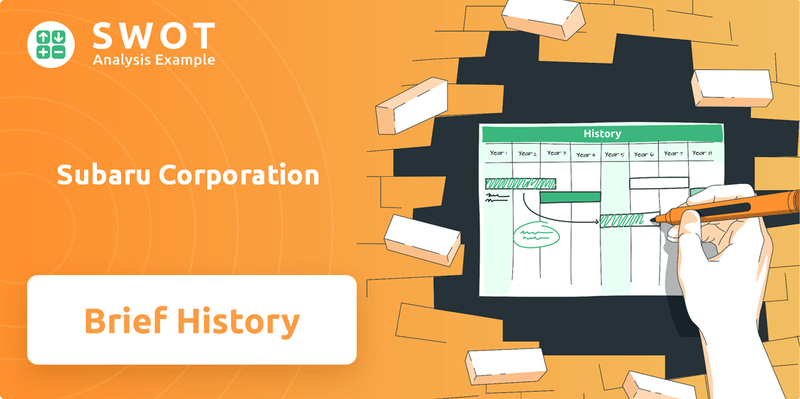
The Subaru Corporation SWOT Analysis offers a deep dive into the company's strengths, weaknesses, opportunities, and threats, revealing the strategic landscape that has shaped its success. The Subaru company, initially known as Fuji Heavy Industries, emerged from the aviation industry, laying the groundwork for its distinctive engineering approach. This brief history of Subaru cars explores how this Japanese car manufacturer evolved, highlighting key milestones like the introduction of its iconic all-wheel-drive system and the evolution of its popular models, including the Impreza and Legacy, which solidified its presence in the global market.
What is the Subaru Corporation Founding Story?
The story of the Subaru Corporation is rooted in the post-World War II restructuring of a Japanese aircraft manufacturer. This transformation led to the formation of Fuji Heavy Industries (FHI), the company that would later give birth to the automotive brand known for its distinctive vehicles.
The origins of the Subaru company can be traced back to the establishment of the Aircraft Research Laboratory in 1917, which evolved into Nakajima Aircraft Company. After the war, this entity was reorganized, eventually leading to the creation of FHI in 1953. This marked the official beginning of what would become a significant player in the global automotive industry.
The vision of Kenji Kita, the CEO of FHI, was pivotal in steering the company towards the automotive sector. His belief that a car should 'have character' set the tone for the brand's future. This focus on distinctiveness helped shape the identity of Subaru cars from the very beginning.
The Subaru history began with the merger of five companies on July 15, 1953, forming Fuji Heavy Industries Ltd. (FHI).
- The initial business model of FHI was diverse, stemming from its aircraft manufacturing background.
- The prototype passenger car, the P-1 (later the Subaru 1500), was completed in 1954.
- The name 'Subaru' was chosen by Kenji Kita, symbolizing unity and the Pleiades star cluster.
- Funding came from the resources of the predecessor companies and strategic investments.
Subaru Corporation SWOT Analysis
- Complete SWOT Breakdown
- Fully Customizable
- Editable in Excel & Word
- Professional Formatting
- Investor-Ready Format
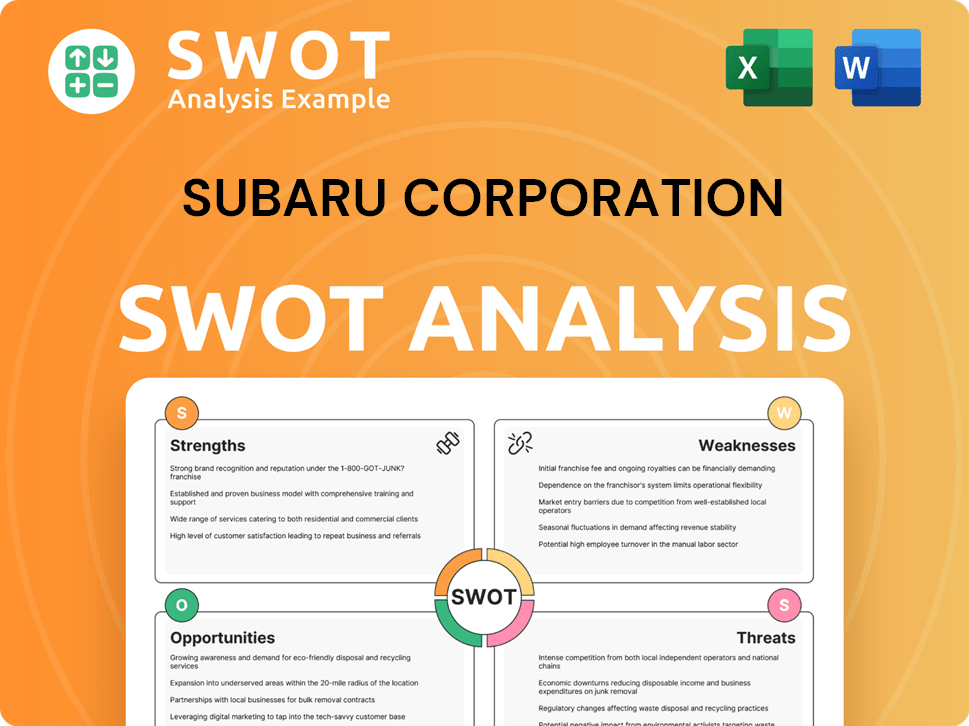
What Drove the Early Growth of Subaru Corporation?
The early growth and expansion of the Subaru Corporation is a fascinating story of innovation and strategic market entry. Fuji Heavy Industries, the parent company, launched its automotive venture with the Subaru 360 in 1958, a microcar designed for post-war Japan. This marked the beginning of the
The
Subaru expanded into international markets in the 1970s, notably entering the United States. The company capitalized on the demand for fuel-efficient vehicles, especially during the oil crises. The Subaru Leone, introduced in 1972, offered four-wheel drive, which further solidified Subaru's reputation for rugged vehicles. By 2024, Subaru's global sales reached approximately 590,000 units.
Subaru focused on engineering principles, including the boxer engine and symmetrical all-wheel drive, becoming core to its brand identity. This early adoption of four-wheel drive was a strategic move that set
Throughout this period, Subaru experienced steady growth, establishing a network of dealerships and gaining a loyal customer base. The
Subaru Corporation PESTLE Analysis
- Covers All 6 PESTLE Categories
- No Research Needed – Save Hours of Work
- Built by Experts, Trusted by Consultants
- Instant Download, Ready to Use
- 100% Editable, Fully Customizable
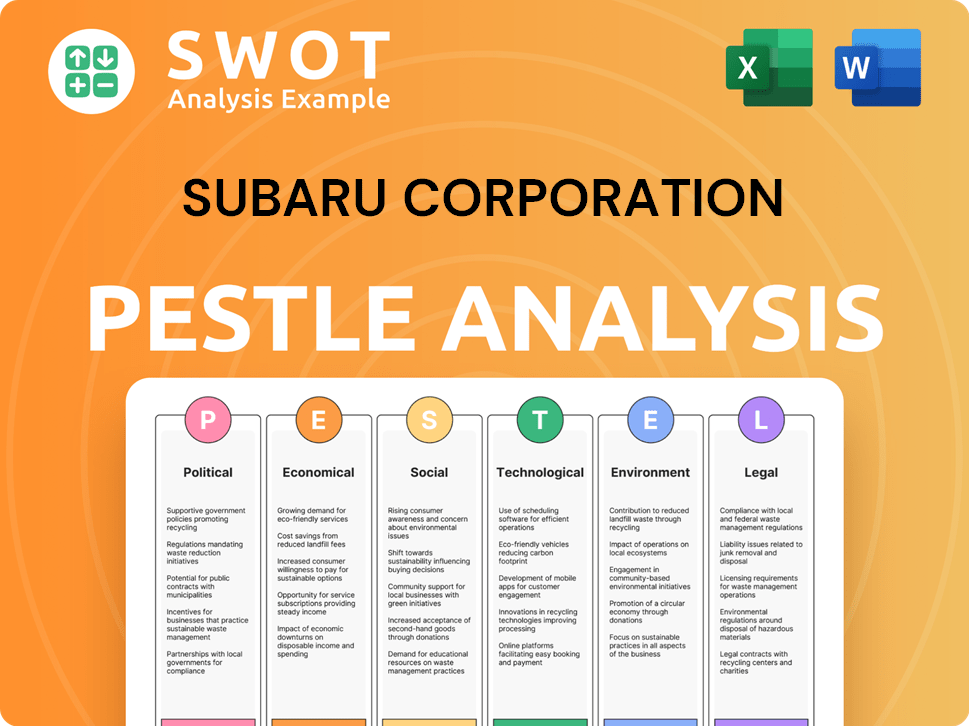
What are the key Milestones in Subaru Corporation history?
The Subaru Corporation, a prominent Japanese car manufacturer, has a rich history marked by significant milestones. From its origins to its present-day status, the Subaru company has consistently strived for innovation and excellence in the automotive industry. The journey of Subaru cars is a testament to its resilience and adaptability.
| Year | Milestone |
|---|---|
| 1953 | Fuji Heavy Industries, the predecessor to Subaru Corporation, was established. |
| 1954 | The Subaru company began its automotive ventures with the development of the P-1 prototype. |
| 1958 | The Subaru 360, a compact and innovative car, was launched, marking the beginning of Subaru's presence in the automotive market. |
| 1972 | Subaru introduced its Symmetrical All-Wheel Drive system in the Leone, a groundbreaking feature. |
| 1989 | The Subaru Legacy was introduced, which became a flagship model for the brand. |
| 2008 | Subaru launched its EyeSight Driver Assist Technology. |
Subaru is known for its innovative engineering, particularly in its engine and drivetrain technologies. The widespread adoption of the horizontally opposed 'boxer' engine is a defining characteristic, providing a low center of gravity and improved balance. Furthermore, the Symmetrical All-Wheel Drive system has become a hallmark, enhancing traction and stability across various models.
The horizontally opposed 'boxer' engine design provides a lower center of gravity, enhancing vehicle stability and handling. This design is a core element of Subaru's engineering philosophy.
Subaru's Symmetrical All-Wheel Drive system provides enhanced traction and stability, particularly in adverse weather conditions. This system is a key differentiator for Subaru cars.
EyeSight uses stereo cameras to monitor traffic and react to potential hazards, significantly reducing the risk of collisions. This technology reflects Subaru's commitment to safety.
Subaru has expanded its presence in key markets, including North America, Europe, and Australia. This expansion has contributed to increased sales and brand recognition.
Subaru is investing in electric vehicle (EV) technology and expanding its EV lineup, as seen with the Solterra. This reflects the company's adaptation to the changing automotive landscape.
Subaru has consistently focused on safety, earning top ratings from organizations like the IIHS. This commitment has enhanced the brand's reputation and customer trust.
Despite its achievements, Subaru has faced challenges in the automotive industry. Competition from larger manufacturers with broader product offerings posed a challenge in the early 2000s. More recently, the semiconductor shortage impacted production volumes in 2023 and 2024.
Subaru faces intense competition from larger automakers with broader product ranges. This requires continuous innovation and differentiation to maintain market share.
The automotive industry, including Subaru, has grappled with supply chain disruptions, such as the semiconductor shortage. These disruptions impact production and sales volumes.
The shift towards electric vehicles (EVs) presents both a challenge and an opportunity for Subaru. Adapting to this transition requires significant investment and strategic planning.
Evolving consumer preferences, including demand for SUVs and EVs, require Subaru to adapt its product lineup and marketing strategies. Understanding the Target Market of Subaru Corporation is crucial.
Subaru, like other automakers, has had to navigate economic downturns that can impact consumer spending and demand for vehicles. This requires financial resilience and strategic planning.
Changes in environmental regulations and safety standards require Subaru to continuously invest in research and development. Compliance is essential for maintaining market access.
Subaru Corporation Business Model Canvas
- Complete 9-Block Business Model Canvas
- Effortlessly Communicate Your Business Strategy
- Investor-Ready BMC Format
- 100% Editable and Customizable
- Clear and Structured Layout
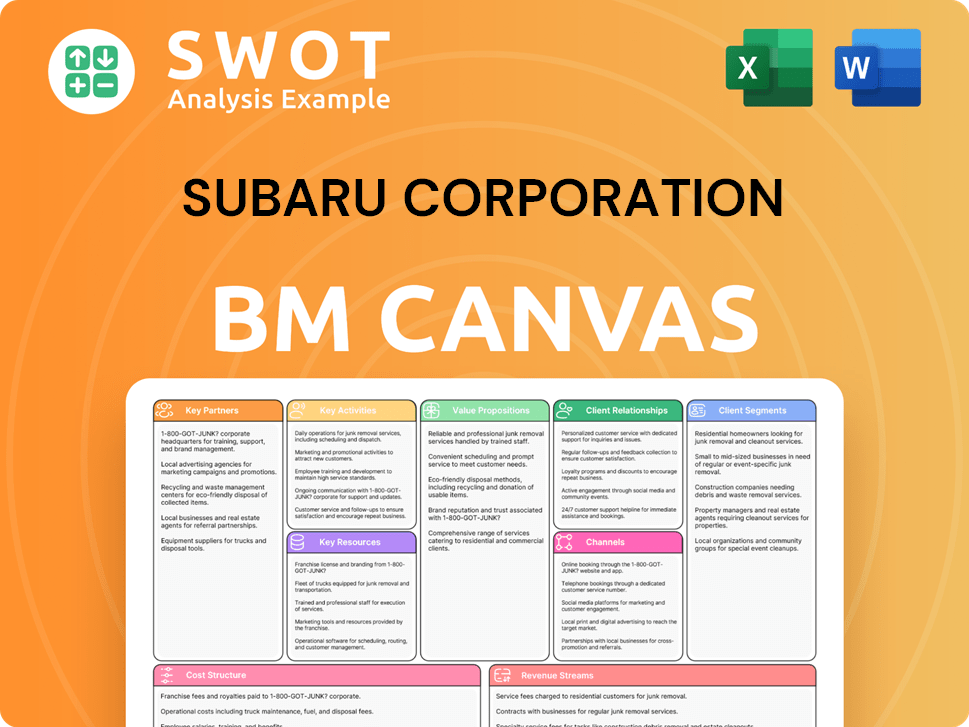
What is the Timeline of Key Events for Subaru Corporation?
The Subaru company has a rich history, evolving from its aviation roots to become a prominent Japanese car manufacturer. Its journey includes significant technological advancements and a growing commitment to sustainable mobility. The company's story is closely linked with its parent company, tracing back to the early 20th century and the formation of Fuji Heavy Industries. Here is a brief history of Subaru cars.
| Year | Key Event |
|---|---|
| 1917 | Aircraft Research Laboratory (later Nakajima Aircraft Company) is established, the precursor to Subaru. |
| 1953 | Fuji Heavy Industries Ltd. (FHI) is formed through the merger of five companies. |
| 1954 | The P-1, Subaru's first passenger car prototype, is completed. |
| 1958 | The Subaru 360, a popular microcar, is introduced. |
| 1961 | The Sambar commercial vehicle is launched. |
| 1966 | The Subaru 1000, featuring the boxer engine and front-wheel drive, is released. |
| 1972 | The Subaru Leone is introduced, offering four-wheel drive, a significant innovation for passenger cars. |
| 1989 | Subaru of Indiana Automotive (SIA) manufacturing plant opens in the United States. |
| 2008 | EyeSight Driver Assist Technology is introduced, enhancing vehicle safety. |
| 2017 | Fuji Heavy Industries Ltd. officially changes its name to Subaru Corporation. |
| 2022 | Subaru launches its first global EV, the Solterra. |
| 2024 | Subaru announces plans to increase EV production capacity and introduce new EV models by 2025 and beyond. |
Subaru Corporation is targeting a future heavily focused on electric vehicles. The company aims for 50% of its global sales to be electric vehicles (EVs) and hybrid electric vehicles (HEVs) by 2030. This strategic shift underscores Subaru's commitment to reducing its environmental impact and meeting evolving consumer demands for sustainable transportation options. The plan includes the introduction of four new battery electric vehicle (BEV) models by the end of 2025.
Safety remains a core value for Subaru. The company plans to make its EyeSight driver assist system standard on all models by 2030. This initiative reflects Subaru's ongoing efforts to enhance vehicle safety features and provide drivers with advanced technologies to prevent accidents and improve overall driving experiences. Owners & Shareholders of Subaru Corporation can expect continued investments in innovative safety technologies.
Subaru is increasing its EV production capacity to meet growing demand. The company aims to produce 400,000 EVs annually by 2030. This expansion is critical for Subaru's success in the rapidly evolving automotive market. Further market expansion is expected, with a focus on introducing new models and increasing manufacturing capabilities to meet global demand.
While Subaru faces challenges in scaling EV production compared to larger competitors, its strong brand loyalty and reputation for safety and all-wheel drive are significant assets. The company's focus on electrification and safety positions it well for future growth. Subaru's ability to leverage its existing strengths will be crucial in navigating the competitive landscape and achieving its long-term goals.
Subaru Corporation Porter's Five Forces Analysis
- Covers All 5 Competitive Forces in Detail
- Structured for Consultants, Students, and Founders
- 100% Editable in Microsoft Word & Excel
- Instant Digital Download – Use Immediately
- Compatible with Mac & PC – Fully Unlocked
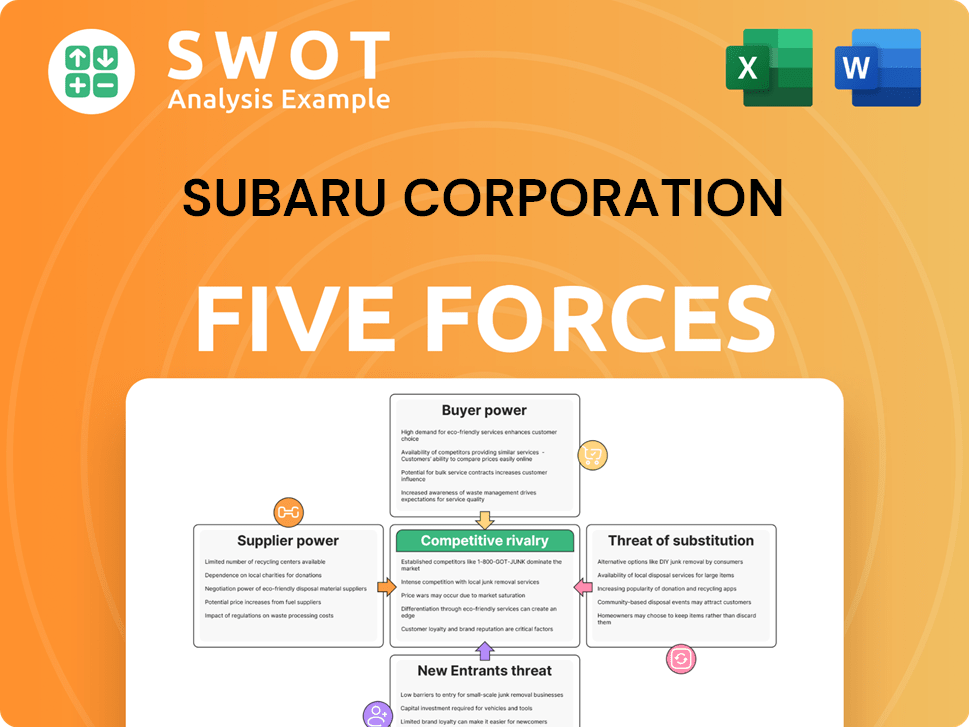
Related Blogs
- What is Competitive Landscape of Subaru Corporation Company?
- What is Growth Strategy and Future Prospects of Subaru Corporation Company?
- How Does Subaru Corporation Company Work?
- What is Sales and Marketing Strategy of Subaru Corporation Company?
- What is Brief History of Subaru Corporation Company?
- Who Owns Subaru Corporation Company?
- What is Customer Demographics and Target Market of Subaru Corporation Company?
Disclaimer
All information, articles, and product details provided on this website are for general informational and educational purposes only. We do not claim any ownership over, nor do we intend to infringe upon, any trademarks, copyrights, logos, brand names, or other intellectual property mentioned or depicted on this site. Such intellectual property remains the property of its respective owners, and any references here are made solely for identification or informational purposes, without implying any affiliation, endorsement, or partnership.
We make no representations or warranties, express or implied, regarding the accuracy, completeness, or suitability of any content or products presented. Nothing on this website should be construed as legal, tax, investment, financial, medical, or other professional advice. In addition, no part of this site—including articles or product references—constitutes a solicitation, recommendation, endorsement, advertisement, or offer to buy or sell any securities, franchises, or other financial instruments, particularly in jurisdictions where such activity would be unlawful.
All content is of a general nature and may not address the specific circumstances of any individual or entity. It is not a substitute for professional advice or services. Any actions you take based on the information provided here are strictly at your own risk. You accept full responsibility for any decisions or outcomes arising from your use of this website and agree to release us from any liability in connection with your use of, or reliance upon, the content or products found herein.